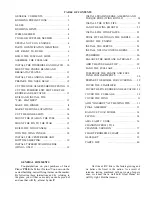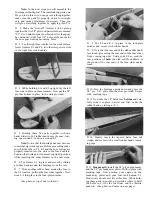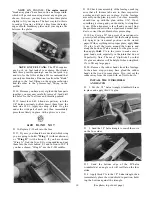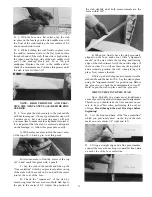
1. You must build the plane according to the plans
and instructions
2. You must take time to build straight, true and
strong.
3. You must use a proper R/C radio that is in first
class condition, the correct sized engine and correct
components (fuel tank, wheels, etc) throughout
your building process
4. You must properly install all R/C and other
components so that the model operates properly on
the ground.
5. You must test the operation of the model before
the first and each successive flight to insure that all
equipment is operating and you must make certain
that the model has remained structurally sound.
6 You must fly the model only with competent
help from a well experienced R/C pilot if you are not
already an experienced and knowledgeable R/C pilot
at this time.
Note- We, as the kit manufacturer, can provide
you with a top quality kit and great instructions, but
ultimately the quality and flyability of your finished
model depends on how you build it, therefore, we
cannot in any way guarantee the performance of your
completed model, and no representations are expres-
sed or implied as to the performance or safety of your
completed model.
BUILDING PRECAUTIONS
Keep in mind that it is impossible for us to
guide you specifically as to every possible matter that
might come up as you build The fun and challenge
is to tackle the problem, using the plans and instruc-
tions for resources as well as the assistance and ad-
vice of fellow builders and your local hobby dealer.
The plans are the basic guide to building Do
not alter or modify the model as represented by
these plans Follow the step by step procedures given
in the building instructions.
Invest in the proper tools for building Knives,
drills and bits, saws, rulers, pliers and screw drivers
are but a few of the tools you will need Check the
list of tools needed in this book and seek the advice
of your dealer.
For best results, you should have such compo-
nents as the engine, tank and radio on hand as you
build for fitting and installation purposes, it is much
more difficult, sometimes impossible, to do a proper
building job when components are purchased and
fitting attempted after most of the model is com-
pleted Always have an eye on installation of the
components you intend to use as you build, take time
to think through and prepare for the installation of
those components Don't hurry! Take your time to
create a well built model that conforms to the plans
Build on a large, flat surface. Use waxed paper over
the part of the plans you are working on to prevent
glues from sticking to the plans Remember a careful
builder will build a warp-free, straight model that
will fly as it was designed to
Read and obey cautions, warnings and direc-
tions on such items as glues, paints and other mater-
ials These are often TOXIC to the human body in
terms of breathing and/or touch Be especially cauti-
ous of cyanoacrylate glues that dry almost instantly
and bond with great power (also known as CA glues)
They require special care since they can be extremely
dangerous if they get into the eyes or on human skin
Watch for ventilation warnings and observe them
Keep small children and pets away from all building
and finishing materials. Keep your building area safe
and clean
We urge you to read through these instructions,
identify all the parts, mark them with their names,
letters or numbers and look over the plans so you
become familiar with what the model will look like
and what the names of the different parts are
Throughout the instructions we will be referring to
the various parts of the model as they are called out
on the plan There is a glossary in the back of these
instructions if you are unfamiliar with any words or
part names. Refer to it for help.
If when you are identifying the parts you find
that a part is missing or broken, please let us know
about it before you start building and we will correct
the problem
CONSTRUCTION PROCEDURE
GLUES (ADHESIVES)
If you look at the "ITEMS NEEDED" list you
will see that we recommend only two basic types of
glue for building the PT-40...CA glue and epoxy.
CA (cyanoacrylate) glues are great for model
building because they set fast Rather than pinning
glued joints together and waiting for hours while the
glue dries, CA glues will harden in a few seconds
while you hold the parts together Thin CA runs
right into a good fitting Joint, so you can assemble
the parts first, then apply thin CA Thick CA is more
like syrup and it will not harden until you press the
two parts together, squeezing the glue out to a thin
layer A related and very handy product is CA Ac-
celerator spray (Zip Kicker or Hot Shot), and is
used to instantly harden CA glue When using CA
glues make sure the parts fit well before gluing
because they don't give you a second chance
If you need time to position glued pieces cor-
rectly or need extra strength, use epoxy glues Epoxy
is normally used in the firewall and engine mount
area and when gluing the two wing panels together
Five minute epoxy (it starts to harden in 5 minutes)
is great for most applications If you need longer time
use 15 or 30 minute epoxy You need not use large
amounts of epoxy. Squeeze out the amounts of epoxy




































